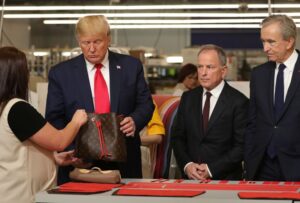Behind the Seams: Unraveling the Challenges of LVMH’s Texas Handbag Factory
In 2017, when Louis Vuitton Moët Hennessy (LVMH) CEO Bernard Arnault, alongside then-President Donald Trump, inaugurated a state-of-the-art handbag factory in Alvarado, Texas, it symbolized a strategic leap into the U.S. market for one of the world’s most prestigious luxury brands. However, this shiny new facility, positioned on a sprawling 250-acre ranch, has encountered substantial hurdles that reveal the complexities of scaling luxury production stateside.
Despite the grand opening fanfare, including promises of job creation and high standards, internal sources have painted a different picture. According to several former employees, the Texas factory has struggled to meet production targets, consistently ranking among the least efficient of Louis Vuitton’s global operations. The challenge, as many insiders have reported, has emanated from a shortage of skilled leather artisans able to maintain the exceptional quality that the brand commands. For instance, it took years for the plant to master the production of the iconic Neverfull handbag’s simple yet intricate components.
One glaring issue has been production waste, which has reportedly soared to as high as 40% due to errors during the cutting, preparation, and assembly processes—far exceeding the typical industry waste rate of about 20%. This discrepancy illustrates not just a struggle with craftsmanship but also the intense pressure placed on employees to meet production numbers. Some former workers described a high-pressure environment in which supervisors sometimes encouraged less-than-ideal quality control measures to hit daily output goals.
While Ludovic Pauchard, Louis Vuitton’s industrial director, acknowledged past issues with quality control, he emphasizes the company’s commitment to ensuring that any product leaving the Texas facility meets the exacting standards of the luxury brand. “This site is a young factory. We are patient, and we ensure every bag produced is worthy of the Louis Vuitton name,” he stated.
The Alvarado factory, named Rochambeau in homage to a French general from the American Revolutionary War, primarily produces components and models like the Metis and Felice pochettes, which are tagged "Made in USA" and sold for several thousand dollars in upscale boutiques. Yet, the nature of the plant’s output raises questions about its long-term strategy. Reports suggest that Louis Vuitton predominantly reserves its more premium handbag lines for production at its traditional European ateliers, opting for the Texas site for less complex models.
LVMH’s investment and operational strategies have also been influenced by significant tax incentives courtesy of Johnson County, including a 10-year, 75% property tax reduction, aimed at slowing down the financial impact of international tariffs on European products. However, the promised workforce numbers have not materialized as expected; while LVMH pledged to create 1,000 jobs at the factory, headcount to date hovers around just 300 employees.
Despite the setbacks, LVMH plans to bolster its employment in Texas, attempting to transfer skilled artisans from existing facilities on the West Coast, albeit with limited success so far. There’s an acknowledgment from executives that relocating skilled labor from California to Texas is more complicated than anticipated, partially due to geographical and cultural differences.
To address issues of training and production quality, LVMH claims that its Texas facility is implementing the same training protocols executed across their global operations, investing in continuous mentorship to ensure workers meet the brand’s craft standards. Despite instances where some artisans have chosen to leave for less demanding positions, the company maintains that comprehensive training for new hires is a priority.
As LVMH navigates the challenges of expanding its manufacturing footprint in the U.S., maintaining the impeccable quality that defines Louis Vuitton will be paramount. The pressure to produce a luxury product at scale in an emerging facility serves as a testament to the complexities of sustaining artisanal craftsmanship in a mass production environment. The ongoing journey of LVMH’s Texas factory not only reflects the intricacies of luxury manufacturing but also illuminates the broader economic landscape as global brands adapt to changing markets and consumer expectations.
At Extreme Investor Network, we closely follow how industry giants like LVMH tackle such challenges, connecting the dots between strategy, craftsmanship, and economic indicators—helping our readers stay informed and ahead in the world of finance. Join us as we continue to explore the evolving narratives of brands shaping our economy.

